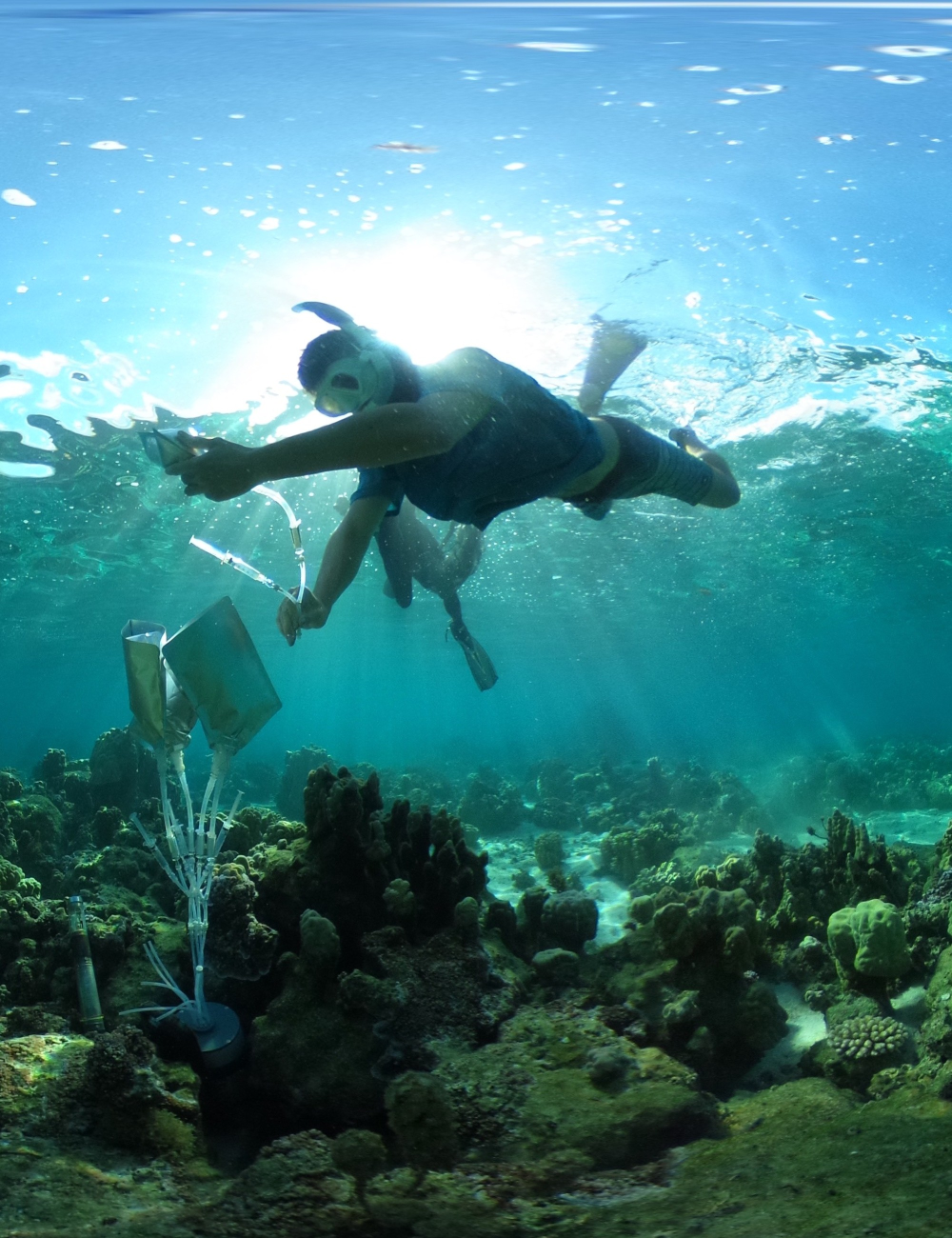“Taste” and “smell” of coral reefs provide insights into dynamic marine ecosystems
Although coral and seaweeds (limu) are fixed to the seafloor, these organisms interact via chemicals dissolved in the water. Despite knowing the importance of these molecules built during photosynthesis and released into the seawater environment, their quantity, energy content and structural diversity have always been a mystery to biologists.
Thousands of molecules
The team applied new analytical techniques to characterize the thousands of small molecules that organisms use for growth, communication and defense. “We have known for years that organic molecules play a big role in the fate of coral reef systems, but until now we did not have the analytical capabilities to analyze the dynamics of thousands of different molecules that make up the coral reef ‘exometabolome’,” said Andreas Haas, from the NIOZ Royal Netherlands Institute for Sea Research.
In the reefs surrounding the island of Mo’orea (French Polynesia), the team collected specimens from two reef-building corals (boulder coral and cauliflower coral), one calcified red alga (crustose coralline algae), one brown alga, and one algal turf (a mix of microscopic filamentous algae). Then, they isolated and analyzed the molecules that each organism released into the seawater during photosynthesis in the daytime and, separately, at night when photosynthesis ceases.
They found that these organisms release large amounts of hundreds of different compounds which ultimately influence the chemistry of the seawater. The compounds determine nutrient concentrations, the growth of decomposers and the availability of vitamins and minerals essential to the plants and animals which inhabit coral reefs.
Snapshot of the diversity
This study provides the first snapshot of the diversity of dissolved chemicals floating among coral reefs and a window into the interactions among organisms that scientists are just beginning to understand.
“There were several surprises with our findings,” said Dr. Linda Wegley Kelly, co-lead author of the work. “First, very few molecules were universal to all five of the organisms we studied. Even the two species of corals made few of the same molecules—more than 85% of the molecules we measured were unique to just one specific organism.” The study ultimately demonstrated the release of over 1000 distinct molecules with diverse structures, pointing the way forward to monitor marine ecosystems at a greater scale and into more detail.
Nutrients in seawater
Another key finding was demonstrating that the molecules released by corals contained many more nutrients than those made by algae, which may have strong implications for the availability of nitrogen, phosphorus, and sulfur in these reef ecosystems. Perhaps more importantly for reef food webs, the work showed that the combination of molecules released into the water by seaweeds were more chemically reduced. “Algae potentially provide more energy to bacteria in the reef than do corals, with implications for how increasing algae on reefs alters the transfer of energy through microbes into larger organisms in the reef ecosystem,” explained Haas.
All around the world reefs and other marine ecosystems are changing and degrading under local pressures from human misuse and overuse as well as global threats of ocean warming and acidification. “One common global shift is a change from coral dominance to increasing biomass of limu, associated with a shift in the structure and function of the ecosystem and the quantity and types of fish and invertebrates that thrive there,” said Dr. Craig Nelson, co-lead author of the work. “Understanding what shifts like this mean to the chemistry of an ecosystem is crital. It helps us understand what changes in coral and algae mean for the ecosystem.”
Exometabolome of the Wadden Sea
This innovative techniques to obtain the exometabolome of an ecosystem will be expanded to new regions and ecosystems in the near future – to the Wadden Sea for instance. Researchers know already much about the biochemistry of species living in the Wadden Sea and other Dutch coastal waters. With this data, measuring the exometabolome and thus the health status of different species in Dutch coastal waters comes within reach. Researchers will be able to learn more from ecosystems with taking less damaging samples from living organisms. Plus it will be possible to collect data in much higher temporal resolution.
Publication
Distinguishing the molecular diversity, nutrient content, and energetic potential of exometabolomes produced by macroalgae and reef-building corals (2022)
Linda Wegley Kelly, Craig E. Nelson, Daniel Petras, Irina Koester, Zachary A. Quinlan, Milou G.I. Arts, Louis-Felix Nothias, Jacqueline Comstock, Brandie M. White, Ellen C. Hopmans, Fleur C. van Duyl, Craig A. Carlson, Lihini I. Aluwihare, Pieter C. Dorrestein, Andreas F. Haas.
Proceedings of the National Academy of Sciences;
DOI: 10.1073/pnas.2110283119
